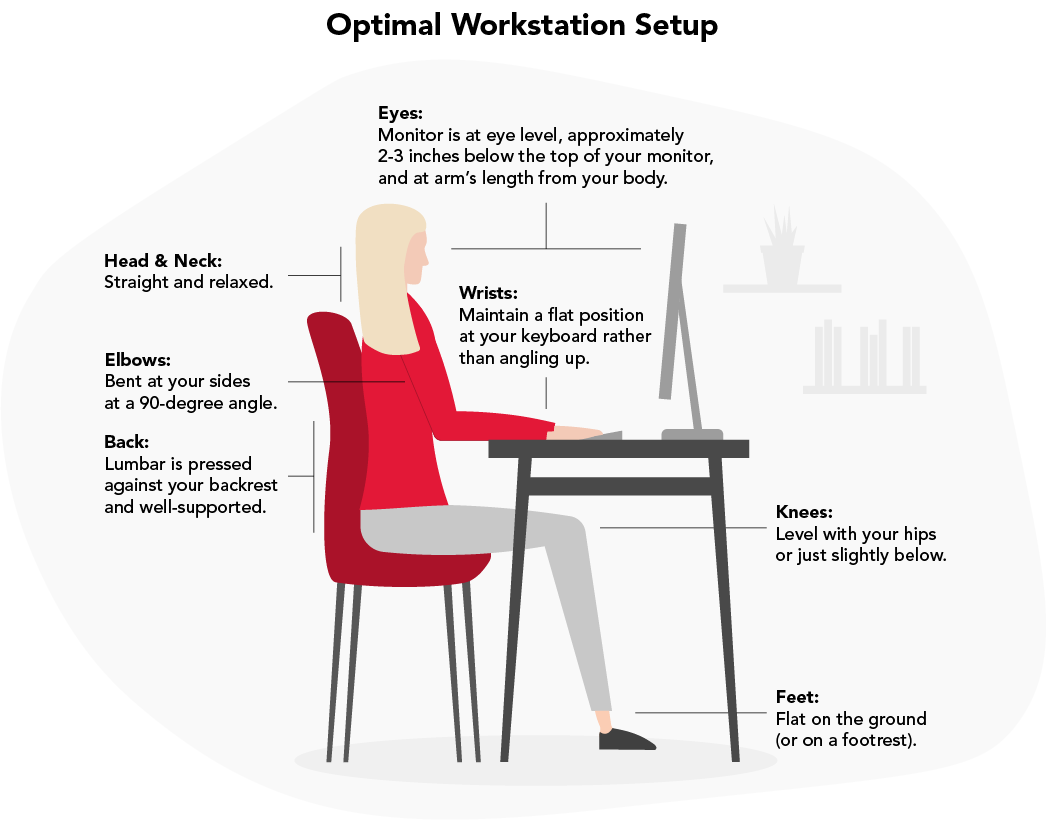
Published May 2021
Decreased movement and increased sitting time, compounded by the stress that often comes with a workday, can take a toll on our bodies. Specifically, prolonged sitting can be the culprit behind neck and back pain, which four out of five Americans had already reported experiencing pre-pandemic. While the discomfort might not seem like a major red flag, over time it can damage our spinal structures and contribute to prolonged and even permanent pain in our necks, shoulders and backs.
Here are some tips and tools you can implement to stay comfortable during your workday and combat neck and back pain and associated long-term damage:
 1. Check your workstation ergonomics.
1. Check your workstation ergonomics.
If you’re currently working from the couch or dining room table of your home, you’re probably not getting the appropriate support for a good postural position. And if you do have a dedicated setup at home or in the office, you could still be putting pressure on your back and neck with a structure that isn’t suited to your body. To relieve strain and prevent injury, use this head-to-toe reference when considering your body placement at your desk area and overall workstation setup:

If you’re working from the office and find that your workstation is causing pain and discomfort, inquire with your employer about potential work station accommodations or reimbursements.
2. Remember to move.
Sitting for long periods of time can lead to muscle and joint stiffness in your neck and back causing you to develop pain and discomfort. Research shows that frequent stretching not only prevents discomfort, it can also improve range of motion and posture, as well as provide stress relief. To promote healthy circulation throughout your workday and keep your body moving, try implementing these three tips:
- Move every 30. Break up sitting time by getting up and moving for one to five minutes every half hour and periodically working from a standing position using a standing desk or high counter.
- Stretch it out. During these quick breaks, try a variety of stretches that target your neck, back, shoulders, legs and knees. You can even do these stretches right at your desk.
- Use digital tools. StretchMinder for iPhone users, Stretching & Eye Exercises for Android users and the Stretch Reminder Google Chrome extension for Chrome users not only remind you to get up, they also share exercises and activity suggestions for healthy movement.
 3. Commit to regular exercise.
3. Commit to regular exercise.
Research from The Office of Disease Prevention and Health Promotion shows that 80% of adults are not meeting the recommended guidelines for aerobic and muscle-strengthening activities. For healthy adults, this includes at least 150-300 minutes (5 hours) a week of moderate-intensity, or 75-150 minutes (2 hours and 30 minutes) a week of vigorous-intensity aerobic physical activity, or an equivalent combination of the two. Regular exercise, especially the kind that involves strengthening the muscles in your neck, shoulders and back, is critical for reducing and preventing neck and back pain. Incorporate a combination of these workouts into your routine using dumbbells, resistance bands and body weight. Additionally, through Harvard Pilgrim’s Living Well at Home program, anyone can jump into a 30-minute strength class between meetings or a one-hour Zumba class after hours.
 4. Explore treatment options.
4. Explore treatment options.
Prior to the pandemic, about 22 million Americans visited chiropractors annually with 35% seeking relief from back pain. While you should always connect with your primary care physician first on what’s right for you, health care options like chiropractic and acupuncture sessions can be an efficient way to alleviate and manage back and neck pain caused by sedentary work. If you’re a Harvard Pilgrim Health Care member, your plan might also include coverage for chiropractic and acupuncture visits. Check your benefits documents for more information.
Learn more about how chiropractic and acupuncture treatments work to relieve pain and restore mobility.
 5. Take care of your mental health.
5. Take care of your mental health.
Outside of physical causes, neck and back pain can also be the result of psychological stress. While exercise can be a powerful stress reliever, making time for activities that bring you joy (this even includes laughing) can help reduce stress. Activities like yoga, meditation and mindfulness, in particular, are also beneficial. Join a free mindfulness session up to twice per week through Harvard Pilgrim’s Living Well at Home program, or consider what mental health services, like therapy, might be right for you.
A sedentary or work from home job doesn’t have to be a pain in the neck. By implementing these tips and strategies long-term, you can help your body stay mobile, flexible and stress-free as you continue to work from home or head back to the office.
To confirm eligibility for any programs or services mentioned in this article as it relates to your specific health plan, please reach out to your account executive or HR benefits team. You may also speak to our member services team at (888)-333-4742 or by sending a secure email. And for plan details and other member resources, log in to the member portal.